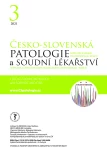Next generation sequencing – a science tool or routine pathology?
Authors:
Lenka Krsková 1; Markéta Kalinová 1; Tereza Němečková 1; Barbora Šípalová 1; Marcela Mrhalová 1; Miroslav Koblížek 1; Jan Balko 1; Jaromír Háček 1; Daniela Nováková-Kodetová 1; Aleš Vícha 2; Petr Brož 2,3; Michal Zápotocký 2; Edita Kabíčková 2; Josef Zámečník 1
Authors place of work:
Ústav patologie a molekulární medicíny, 2. LF UK a FN Motol, Praha
1; Klinika dětské hematologie a onkologie, 2. LF UK a FN Motol, Praha
2; Bioxsys s. r. o., Ústí nad Labem
3
Published in the journal:
Čes.-slov. Patol., 57, 2021, No. 3, p. 136-143
Category:
Přehledový článek
Summary
Molecular assays for translocation detection in different tumors have gradually been incorporated into routine diagnostics. However, conventional methods such as fluorescence in situ hybridization (FISH) and reverse transcriptase-PCR come with several drawbacks. Next-generation sequencing (NGS) can provide in-depth detection of numerous gene alterations. The anchored multiplex PCR assay proved to be a fast and easy-to-analyze approach for routine diagnostics laboratories. Next-generation sequencing-based anchored multiplex PCR technique (Archer FusionPlex Panels) is beneficial in both diagnosis for patient care and in identification of a novel fusion breakpoint in tumors.
NGS is useful in identifying targetable molecular changes (point mutations, fusion genes, etc.) in tumors that can serve as a rationale for inclusion of patients with advanced disease in ongoing clinical trials and allow for better risk stratification.
Keywords:
next generation sequencing (NGS) – somatic mutations – Fusion genes – targeted therapy
Zdroje
1. Sánchez R, Ayala R, Martínez-López J. Minimal residual disease monitoring with nextgeneration sequencing methodologies in hematological malignancies. Int J Mol Sci 2019; 20(11): 2832.
2. Helman E, Nguyen M, Karlovich CA, et al. Cell-Free DNA Next-Generation Sequencing Prediction of Response and Resistance to Third-Generation EGFR Inhibitor. Clin Lung Cancer 2018; 19(6): 518-530.
3. Bettegowda C, Sausen M, Leary RJ, et al. Detection of circulating tumor DNA in earlyand late-stage human malignancies. Sci Transl Med 2014; 6(224): 224ra24.
4. Chen M, Zhao H. Next-generation sequencing in liquid biopsy: cancer screening and early detection. Hum Genomics 2019; 13(1): 34.
5. Froňková E. Next-generation sequencing. Cesk Patol 2013; 49(3):129-32.
6. Alvarez-Breckenridge C, Miller JJ, Nayyar N, et al. Clinical and radiographic response following targeting of BCAN-NTRK1 fusion in glioneuronal tumor. NPJ Precis Oncol 2017; 1(1): 5.
7. Schreck KC, Grossman SA, Pratilas CA. BRAF mutations and the utility of RAF and MEK inhibitors in primary brain tumors. Cancers (Basel) 2019; 11(9): 1262.
8. Gullapalli RR, Lyons-Weiler M, Petrosko P, Dhir R, Becich MJ, LaFramboise WA. Clinical Integration of Next-Generation Sequencing Technology. Clin Lab Med 2012; 32(4): 585- 599.
9. Heyer EE, Deveson IW, Wooi D, et al. Diagnosis of fusion genes using targeted RNA sequencing. Nat Commun 2019; 10(1): 1388.
10. Lam SW, Cleton-Jansen AM, Cleven AHG, et al. Molecular Analysis of Gene Fusions in Bone and Soft Tissue Tumors by Anchored Multiplex PCR–Based Targeted Next-Generation Sequencing. J Mol Diagn 2018; 20(5): 653- 663.
Štítky
Patologie Soudní lékařství ToxikologieČlánek vyšel v časopise
Česko-slovenská patologie

2021 Číslo 3
Nejčtenější v tomto čísle
- Sekvenování nové generace – nástroj vědy či rutinní patologie?
- Doporučení pro testování PD-L1: metodika testování a reportování výsledků Verze_1 (17. 5. 2021)
- Molekulární testování u karcinomu endometria (společné doporučení ČOS, onkogynekologické sekce ČGPS, SROBF a SČP ČLS JEP)
- Využití metylačního profilu v diagnostice a prognostice nádorových onemocnění CNS
